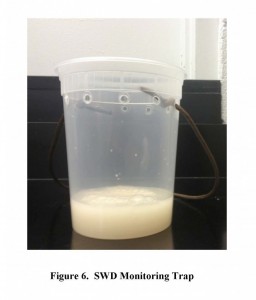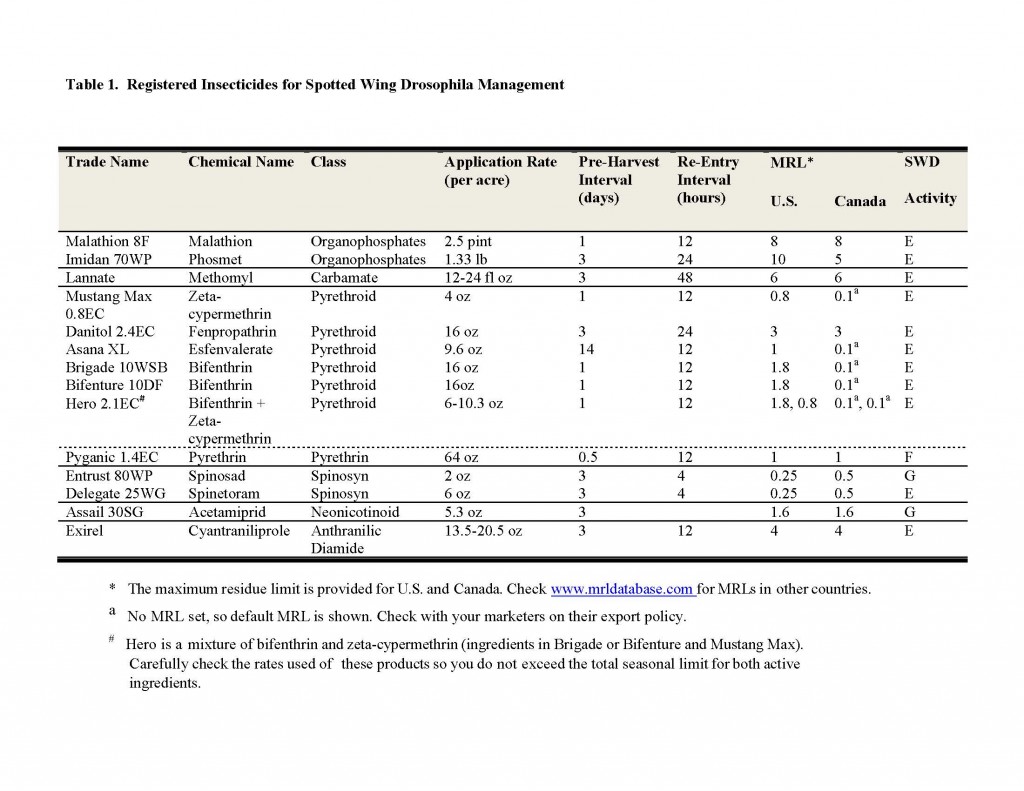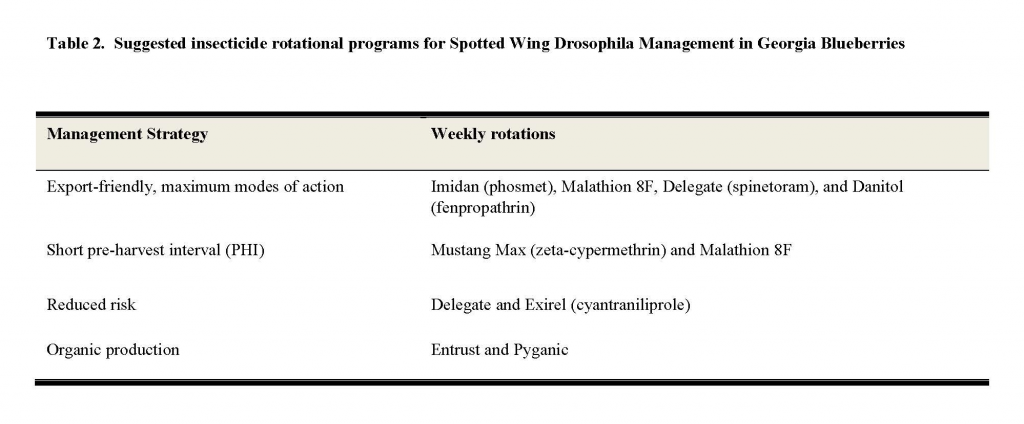Detections of SWD from 2010 to 2014
The spotted wing drosophila (SWD), Drosophila suzukii (Matsumura) (Diptera: Drosophilidae) is an invasive and economically important pest of many soft-skinned fruits such as blueberries, blackberries, raspberries, strawberries, cherries, and other. Since its first detection in California in 2008, SWD spread rapidly across the United States. It was first found in Georgia in 2010 and since then this small vinegar fly has impacted the $255 million Georgia blueberry industry with crop losses of up to 20% annually. SWD has been reportedly detected in many counties across the State. However, a statewide survey is underway to confirm reports and develop a SWD distribution map in the State of Georgia.
IDENTIFICATION AND LIFE CYCLE
The SWD flies have brownish-yellow thorax, black stripes across the abdomen, and distinct red eyes. Males have dark spots on the wingtips and black combs on the forelegs (Figure 1). Female SWD lack the spots and black combs, but have a very large serrated ovipositor (Figure 2). The adult female punctures the skin of intact fruit using its serrated ovipositor and deposit white eggs just under the fruit skin. Two spiracles (breathing tubes) which are attached to the egg extend out of the fruit through the hole, also known as a sting. Eggs hatch after 1-3 days and the larvae (maggots) continue to feed in the fruit. While in the fruit, the larvae develop through three instars. The respiratory ducts and mouth of the larvae develop with each instar. The third instar (Figure 3) has large hook-like mouthparts and branching anterior spiracles which protrude through its larval exterior. After 5-7 days, the third instar exits the fruit to pupate. The puparium (Figure 4) is initially bright white, but it browns as it ages. The fly remains in its puparium for 3-15 days until the adult emerges. Adult males may not develop the characteristic spot on the wingtips until 10 hours after eclosing, and reproductive maturity will typically be reached after 1-2 days. Mature females are extremely productive, laying 1-3 eggs per oviposition site, in 7-16 sites per day, for 10-59 days. One female can produces 300-600 eggs within a lifetime.




SWD DAMAGE
Blueberries are susceptible to SWD damage as soon as the maturing fruit begin to change color from green to purple up until they are harvested. Typical vinegar flies infest damaged, overripe or rotting fruit for egg-laying, but a female SWD can lay eggs into intact fruit using its serrated ovipositor. Although the fruit receives some damage during egg insertion which increases its vulnerability to fruit pathogens, the majority of the damage is caused by larval feeding. The SWD larvae eat the fruit pulp causing fruit to collapse often within days of egg-laying. Figures 5A-L clearly demonstrate progression of SWD damage from oviposition to complete collapse of a blueberry. Because SWD attacks commercially-viable fruit, SWD poses a significant risk for blueberry growers. If SWD is not managed properly, fruit infested with SWD larvae may be harvested which will result in either downgrading or rejection of the entire shipment. It is therefore extremely important that Georgia blueberry growers implement effective monitoring and management strategies to minimize the impact of this devastating pest blueberry production.


MONITORING
The first and the most important step in the effective management of this pest is to determine whether SWD are present in your orchard and when they become active. To determine this, monitoring should be in place from early stages of fruit development until the end of harvest.
There are several trap designs available to detect the presence of SWD, though some are considered better than others. Studies have found that traps with a taller shape and greater bait surface area might attract more SWD. Holes in the traps should be wide enough that the flies can enter, but narrow enough to keep the bait from evaporating too quickly. If the holes are too wide this will also attract unwanted, larger insects.
A suggested trap design would consist of a 32-ounce deli cup with a corresponding lid. To hang the trap use approximately 20” of 14-gauge, insulated copper wire, secured into two of the holes. The deli cup should have 10-12, 3/16-inch holes located just below the rim. The holes should encircle about 2/3 of the way around the cup, leaving an unpunctured section for pouring the bait. The trap should be baited with 150 mL of a yeast-sugar solution (Figure 6).

Traps should be placed in shaded areas in or around the fruits, and the traps should be checked weekly. While checking the traps, determine if SWD is present, count the number of male and female SWD, and replace the trap with fresh bait. For detailed instructions on how to make these traps, please watch this video.
SWD baits and lures include synthetic lures, yeast and sugar mixtures, and apple cider vinegar (ACV). Studies have shown that apple cider vinegar is not the most attractive bait, but it is often used because ACV is easy to find at the local stores and the traps are easy to service. The yeast and sugar solution, especially during warmer temperatures, is currently the best alternative. Traps baited with yeast and sugar trapped SWD earlier and in greater numbers than those with the ACV. Although these traps are messier to service, the yeast bait is less expensive than the ACV traps, and of course earlier detection is extremely important and allows for timely implementation of management strategies to protect fruit from infestation. In order to maximize the chances of trapping SWD, we recommend a minimum of one yeast and sugar-baited trap every 5-10 acres. If there is a woodland habitat surrounding the orchard, hang the traps in the orchard close to the woodland habitat. It might help with the earlier detection of the fly activity.
The traps for SWD should be hung in a shaded area of the bush canopy in the middle of the fruiting zone. Keep the trap clear of vegetation with the holes exposed so that SWD can easily fly in. Check the traps at least once a week and add fresh bait yeast-sugar bait each time traps are checked. Old bait should be poured into a bucket for disposal away from the orchard. The SWD captures should be recorded each week in a log book including number of male and female flies separately, date of the trap change, trap location and if possible GPS coordinates of the trap location.
For flies suspected of being SWD that are trapped in counties where this insect has not yet been reported, we encourage growers, scouts, and consultants to place flies into another container and then send them to your local County Agent for identification. The County Agents should report the first catch of SWD in their respective Counties to us at ashsial@uga.edu to help with a survey currently underway to develop a map of SWD distribution in the State of Georgia.
Here are the recipes for the two most commonly used baits:
1. Apple cider vinegar
Unscented soap (4 ml/gal)
Use 150 ml of this solution per trap.
2. Yeast and sugar
2 Tbsp yeast (ca. 8 g)
8 Tbsp sugar (ca. 40 g)
24 fl oz water
0.76 ml unscented soap
Use 150 ml of this solution per trap.
This will make enough bait for just over 4 traps.
Supplies
Traps (see below)
Apple cider vinegar – 5% “real” ACV
Yeast – Red Star Dry Active Yeast (https://bit.ly/YqNPwq)
Sugar – White sugar, brand not important
Unscented soap – Seventh Generation (https://bit.ly/18Pta6p)
SAMPLING FRUIT FOR SWD LARVAE
If you suspect has been or may be infested by SWD, then you should sample fruit prior to harvest to determine the level of infestation by extracting larvae from the berries using one of three methods: sugar, salt, or boiling method. Each method require 2-4 cups (about 100) of blueberries.
The sugar method involves adding a cup of sugar solution (1/4 cup of sugar in 4 cups of water) to crushed berries in a seal-top gallon plastic bag. Reseal the bag and inspect the liquid for larvae floating on the surface on the sugar solution. For detailed instructions on how to use sugar solution to sample blueberries for SWD, please watch this video.
The salt method consists of combining a salt solution (1 tablespoon of salt and 1 cup of water) and berries in a seal-top gallon plastic bag. Without smashing the berries lightly mix the berries into the solution. Allow the berries and solution to sit in the bag for about 15 minutes. After that time, look for larvae that have emerged from the berries and are crawling on the berry surfaces. For detailed instructions on how to use salt solution to sample blueberries for SWD, please watch this video.
The boiling method is most and provides the best estimate of the degree of SWD infestation. The sample of fruit should be placed in a heatproof pan and covered with water. Heat the water and boil the berries for one minute. Next pour the fruit mixture over a shallow, dark-colored pan covered with a mesh screen. Mash the fruit over the mesh screen with a spoon. Finally, lightly wash the berries with cold water to the rinse any remaining larvae into the pan. Inspect the pan for larvae floating on the liquid. The fruit processors most commonly use this method. For detailed instructions on how to use the boiling method to sample blueberries for SWD, please watch this video.
MANAGEMENT
Measures to control Spotted Wing Drosophila are available, but methods are constantly being refined as new research and information becomes available, so keep informed through your local County Agents, and through our UGA Blueberry Blog. Currently there is no economic threshold for SWD, and the benefits of the treatment significantly outweigh the costs. We are therefore recommending a conservative approach, if SWD is detected at your or at your neighbor’s farm, then control measures must be implemented. SWD control involves cultural control methods and/or chemical control methods.
CULTURAL CONTROL
Cultural control strategies should be part of the overall SWD management program and include sanitation, frequent harvest intervals, and exclusion netting. Sanitation, one of the most important cultural control methods, consists of removing over-ripe or fallen fruit from the field and disposing of them properly. Another sanitation method is the removal of wild plants that can be potential hosts for SWD including wild plants with berries such as grapes, beautyberry, elderberry, pokeweed, pokeberry, honey suckle, nightshade, dogwood, spicebush, and autumn olive, but the exact role of this approach in SWD control programs has yet to be investigated. Furthermore, frequent harvest intervals can keep susceptible fruit off of the bushes. During peak SWD season, harvest can be 1-2 times per week. Lastly, netting with mesh size less than .98mm can also protect the blueberry bushes from SWD. Small-scale growers or organic growers, due to their limited amount of control options, can utilize the mesh netting method to reduce SWD infestation.
If infested berries are found in the field or at the processor, they should be bagged inside plastic bags to prevent fly escape and placed in the sun to kill SWD before they complete development and emerge to continue infesting more fruit. If there is a large pile of fruit, it can be solarized by placing clear plastic sheet over the fruit in a sunny location and sealing well around the edge using soil. The infested fruit may be buried in the soil to prevent emergence, however, it will be effective only if burial depth is at least 30 cm or more otherwise flies can survive in the cool soil and emerge. Freezing berries is another way to kill SWD, and refrigerating them will stop further development of larvae, and may kill them after long periods of refrigeration. Keeping berries cool during the supply chain from processor to market to consumer will also minimize the chance that larvae will develop in berries.
CHEMICAL CONTROL
When implementing chemical control methods, choose from among the insecticides that have been shown to be effective against SWD. Fruits become susceptible to SWD once fruit coloration has started (when blueberries turn from green to purple). Treatment programs should begin as soon as the berries start to change color and continue through the end of harvest. Before administering pesticides growers should make sure their sprayers are calibrated and functioning properly. When administering pesticides, growers should ensure they are providing thorough coverage to the fruit and all areas of the bush. Table 1 includes a list of insecticides registered for use in blueberries that have shown high activity against SWD. Selection of insecticides for SWD control in blueberries, take into account the efficacy, chemical class, harvest date, pre-harvest interval, re-entry restrictions, and your target markets. The level of control achieved will depend on the SWD population, timeliness of application, coverage of fruit, and product effectiveness. If you are exporting fruit, also check carefully on the maximum residue limits (MRL) for the destination country. Make sure to rotate classes of insecticides to delay the development of insecticide resistance. Table 2 includes some suggested insecticide rotational programs to control SWD under different management strategies. This is particularly important for organic growers because there are only two classes of insecticides registered for use against SWD in organically produced blueberries.
When applying insecticides, growers/applicators must follow the label instructions for blueberries because THE LABEL IS THE LAW.
SWD CONTROL OPTIONS FOR ORGANIC BLUEBERRIES
Insecticides registered for organically produced blueberries are less effective against SWD than conventional insecticides and have shorter residual activity. However, SWD can be managed successfully through more intensive monitoring, timely application if flies are detected, and frequent application of the available insecticides. Cultural control strategies described in an earlier section of this update will also be important to help reduce the overall population levels and should be implemented if possible. There are only two organic insecticides effective against SWD which include Entrust and Pyganic. There are some restrictions on how much or how many times Entrust can be applied per season, so please read the label for details. Make sure to rotate Entrust with Pyganic to reduce the risk of resistance development in SWD.


SUMMARY
SWD is clearly one of the most devastating pests in the history of Georgia blueberry production. It is therefore extremely important for growers to implementing management strategies in a proactive manner in order to minimize the impact of this pest. Following are the key components of effective management of SWD:
1. Monitor fields with traps and check the traps weekly starting from the fruit-set until the end of harvest.
2. Make sure to check the trapped flies and correctly identify SWD to determine presence and number of male and female SWD.
3. Once SWD is detected in the traps while the berries are ripening or ripe, apply effective insecticides registered for blueberries to protect the fruit. For detailed information about insecticides for SWD in blueberries (see Table 1 and Table 2, and also other resources available locally https://www.ent.uga.edu/labels/BlueberryInsecticide.pdf and regionally https://www.smallfruits.org/SmallFruitsRegGuide/Guides/2014/BlueberrySprayGuide11252013.pdf).
4. Make sure to rotate classes of insecticides to delay the development of insecticide resistance.
5. Continue monitoring to evaluate your management program, and respond in a timely manner if needed.
6. If possible, harvest frequently and remove leftover fruit from the orchard to reduce fly feeding and breeding resources.
7. Keep yourself updated about this pest to informed decisions to manage it. Find the latest information at our UGA Blueberry Blog (https://site.caes.uga.edu/blueberry/) and sign up to receive updates instantly.
2014 UGA SUGGESTED SWD INSECTICIDE REGIME FOR BLUEBERRIES

